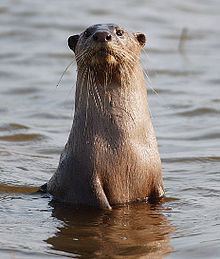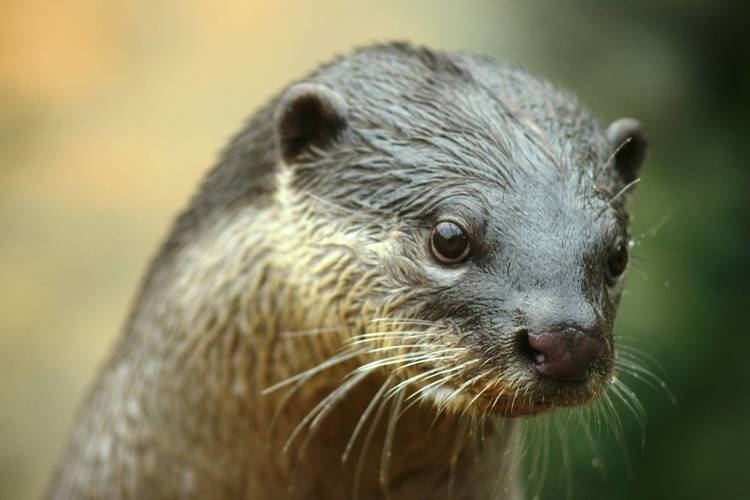Subfamily Lutrinae Rank Species | Phylum Chordata Higher classification Lutrogale | |
 | ||
Similar Otter, Hairy‑nosed otter, Spotted‑necked otter, Aonyx, African clawless otter | ||
Smooth coated otters bishan park 4
The smooth-coated otter (Lutrogale perspicillata) is a species of otter, the only extant representative of the genus Lutrogale. The species is found in most of the Indian Subcontinent and eastwards to Southeast Asia, with a disjunct population in Iraq. As its name indicates, the fur of this species is smoother and shorter than that of other otters.
Contents
- Smooth coated otters bishan park 4
- Territorial dispute between 2 families of smooth coated otters dtd 20 oct 2015 fight
- Characteristics
- Distribution and habitat
- Ecology and behavior
- Reproduction
- Threats
- Conservation
- In culture
- References

Territorial dispute between 2 families of smooth coated otters dtd 20 oct 2015 fight
Characteristics

Smooth-coated otters are relatively large for otters, from 7 to 11 kg (15 to 24 lb) in weight and 59 to 64 cm (23 to 25 in) in head-body length, with a tail 37 to 43 cm (15 to 17 in) long. They may be distinguished from other species of otters by a more rounded head and a hairless nose in the shape of a distorted diamond. The tail is flattened, in contrast to the more rounded tails of other species. The legs are short and strong, with large webbed feet bearing strong claws. As their name suggests, they have unusually short and sleek fur; this is dark to reddish brown along the back, while the underside is light brown to almost grey in color. Females have two pairs of teats.
Distribution and habitat

Smooth-coated otters occur throughout much of the Indian Subcontinent and contiguous regions of Southeast Asia, in the Indomalaya ecozone. An isolated population of the species is also found in the marshes of Iraq.

Smooth-coated otters are found in areas where fresh water is plentiful — wetlands and seasonal swamps, rivers, lakes, and rice paddies. Where they are the only species of otter, they may be found in almost any suitable habitat, but where they are sympatric with other species, they avoid smaller streams and canals in favour of larger bodies of water. They have adapted to life in an aqueous habitat, but are nonetheless comfortable on land, and may travel long distances overland in search of suitable habitats.
Although they are often found in saltwater near the coast, especially on smaller islands, they require a nearby source of fresh water.
There are three recognised subspecies:
Fossils belonging to the genus Lutrogale are known from the early Pleistocene of Java. Two fossil species, an earlier form, L. robusta, and the more recent L. palaeoleptonyx, are known, and may have fed primarily on shellfish, rather than on fish as the current species does.
Ecology and behavior
Smooth-coated otters are social and hunt in groups. They are mainly diurnal, and have a short lull in activity during midday.
They spend the night in dens dug in dense vegetation, under tree roots, or among boulders. They use scent to communicate both within the otter species, and with other animals. Each otter possesses a pair of scent glands at the base of the tail which are used to mark land or objects, such as rocks or vegetation, near feeding areas in a behavior called sprainting. They also communicate through vocalisations such as whistles, chirps, and wails.
Some may construct permanent holts near water, in a layout similar to that of a beaver dam, with an underwater entrance and a tunnel that leads to a nest above the water.
Fish comprise over 70% of their diet, but they also eat reptiles, frogs, insects, crustaceans, and small mammals. Especially in areas where other species of otter are also found, they prefer larger fish, typically between 5 and 30 cm (2.0 and 11.8 in) in length. They sometimes hunt in groups of up to 11 individuals.
In the Kuala Selangor Nature Park, an otter group was observed hunting. They formed an undulating, slightly V-shaped line, pointing in the direction of movement and nearly as wide as the creek. The largest individuals occupied the middle section. In this formation, they undulated wildly through the creek, causing panic‑stricken fish to jump out of the water a few metres ahead. They suddenly dived and grasped the fish with their snouts. Then they moved ashore, tossed the fish up a little on the muddy part of the bank, and swallowed it head‑first in one piece.
A group of otters can have a feeding range of 7 to 12 km2. A single adult consumes about 1 kg of food per day in captivity.
Reproduction
Smooth-coated otters form small family groups of a mated pair with up to four offspring from previous seasons. Copulation occurs in water and lasts less than one minute.
So long as the food supply is sufficient, they breed throughout the year, but where otters are dependent on monsoons for precipitation, breeding occurs between October and February. A litter of up to five pups is born after a gestation period of 60 to 63 days. However, on 14 June 2014, a smooth-coated otter called Ping at Wingham Wildlife Park in the UK gave birth to a litter of seven young. The mothers give birth to and raise their young in a burrow near water. They may either construct such a burrow themselves, or they may take over an abandoned one. At birth, the pups are blind and helpless, but after 10 days, their eyes open, and they are weaned at about three to five months. They reach adult size at about a year of age, and sexual maturity at two or three years.
Threats
Major threats to Asian otter population are loss of wetland habitats due to construction of large-scale hydroelectric projects, reclamation of wetlands for settlements and agriculture, reduction in prey biomass, poaching, and contamination of waterways by pesticides. In most Asian countries, increased human population during the last century, inadequate and ineffective rural development programmes have not been able to address the problems of poverty, forcing people to be more and more dependent on natural resources. Consequently, most of the wetlands and waterways do not have adequate prey base for sustaining otter populations. Wetlands and waterways are polluted by eutrophication and accumulation of persistent pesticides such as chlorinated hydrocarbons and organophosphates through agricultural runoffs. Increased pesticide use is not only regarded as a major obstacle to the development of rice-fish culture, but also poses a danger to all predators feeding on aquatic prey in the area. In the entire South and Southeast Asia, severe conflict exists between otters and humans, because of poverty and recent increases in aquaculture activities leading to indiscriminate killing of otters. Many important habitats of smooth-coated otters have been lost to development activities. In Southeast Asian countries, intentional otter trapping does not seem to occur, though it is prevalent in India, Nepal, and Bangladesh.
Due to the draining of the Mesopotamian Marshes during the presidency of Saddam Hussein, the Iraqi population of otters was feared to have perished. A biodiversity site review in 2009 found tracks of an otter, suggesting the population may have survived, and comprehensive surveys in 2005–2012 found that it survived at several locations (even extending its range to Iraqi Kurdistan, far north of its previously known distribution).
Conservation
Since 1977, Lutrogale perspicillata is listed on CITES Appendix II. It is a protected species in almost all the range countries, which prohibits its killing. But most range countries are not able to control the clandestine trade leading to extensive poaching.
The smooth-coated otter is listed as a vulnerable species. Their range and population are shrinking due to loss of wetland habitat and contamination of waterways by pesticides. Most range countries are not able to control the clandestine trade leading to extensive poaching. Smooth-coated otters are protected in India under the Wildlife (Protection) Act, 1972. Smooth-coated otters are used for commercial fishing in southern Bangladesh. These otters are bred in captivity, trained, and used to chase fish into fishing nets. This fishing technique is currently used by about 300 fishermen, with an additional 2,000 people indirectly dependent on the technique for their livelihood.
In culture
The smooth-coated otter was featured on the BBC documentary, Planet Earth, in the episode entitled "Fresh Water" (aired in the UK on March 19, 2006, and in the US on April 15, 2007). In this episode, it is shown openly pestering an adult crocodile. They are also shown in Singapore in the final episode of Planet Earth II during a segment on the "greening" of cities.
Ring of Bright Water by Gavin Maxwell describes how the author brought a smooth-coated otter from Iraq to Scotland.
